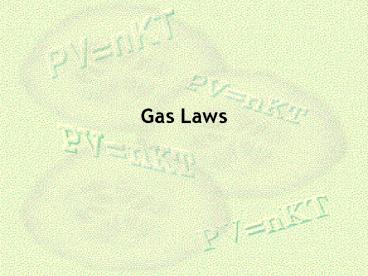Gas Laws - PowerPoint PPT Presentation
1 / 27
Title:
Gas Laws
Description:
Partial Pressure of a Gas Depends on the Mole Fraction of the Gas ... Diffusion - Gradual mixing of molecules of two or more substances due to random ... – PowerPoint PPT presentation
Number of Views:2565
Avg rating:3.0/5.0
Title: Gas Laws
1
Gas Laws
2
Properties of Gases
- Compressible
- Fluid
- Always form homogenous mixtures with other gases
- Gases only occupy only about 0.1 of their
container
3
Pressure
- Pressure molecules bumping into the walls of
the container - P force
- area
- Pressure goes up with more molecules, therefore P
a n - PSI pounds per square inch
4
Liquid Pressure
Why not equal height?
Different densities
H2O
Mass (force) same on both sides
C2H5OH
127 cm
x
100 g/cm2 PEtOH
x
100 cm
100 g/cm2 PH2O
5
Gas Pressure
6
Gas Pressure
- 1 atm
- 76 cm Hg
- 760 mm Hg
- 760 torr
SI Unit Pascal Pa (kg/m2) 1 atm 101325 Pa
7
4 Measurable Properties of Gas
What can you change?
- Pressure
- Volume
- Temperature
- Number of Molecules (moles)
8
Gas Laws
- Boyles Law
- Charles Law
- Avagadros Law
9
Boyle's Law
- Pressure varies inversely with volume
- Volume varies inversely with pressure
The volume of a sample of gas is inversely
proportional to its pressure, if temperature
remains constant.
10
Boyle's Law
P1V1 P2V2
Where P Pressure and V Volume, and
temperature is constant
11
Charles' Law
- Effects of temperature on a gas
- Pressure varies with Temperature
The volume of a quantity of gas, held at
constant pressure, varies directly with the
Kelvin temperature.
12
Charles' Law
Where V Volume and T Temperature, and at
constant pressure
13
Avagadros' Law
Equal volumes of gas at constant temperature and
pressure have equal numbers of molecules.
14
Gas Laws
- Boyles Law
- Charles Law
- Avagadros Law
- or PV constant
- or V/T constant
- or V/n constant
15
Ideal Gas Law
Boyles Law
Charless Law
Avagadros Law
Expressed Mathematically
16
Need consistent T and P
- Standard Temperature and Pressure
- STP
- Standard T 273.15 K
- Standard P 1 atm
- R Universal gas constant
17
PV nRT
18
Determining Molar Mass of a Gas Using the Ideal
Gas Law
Where m mass M molar mass
So
Density and the Ideal Gas Law
19
Gas Laws and Chemical Reactions
Given the general reaction
aA ? bB cC
When a, b, c are the stoichiometric ratios of
reactants A, B, C, you can calculate V, P, n,
or T for any reagent using the Ideal Gas Law.
20
Gas Mixtures and Partial Pressures
Daltons Law of Partial Pressures The total
pressure of a mixture of gases equals the sum of
the pressures of the components.
John Dalton (1766 1844)
Expressed mathematically
Ptotal P1 P2 P3
At constant V T, P depends only on n
21
Gas Mixtures and Partial Pressures
22
Consider a mixture of three gases
Where
nA moles of gas A
So
nB moles of gas B
nC moles of gas C
And
ntotal nA nB nC
23
Partial Pressure of a Gas Depends on the Mole
Fraction of the Gas
Where ni moles of one component of the
mixture
For a mixture of components A, B, C
So
PA XAPtotal
24
Kinetic Molecular Theory
Gas molecules are in constant motion and
completely fill the volume provided. The gas
molecules collide with the walls of their
container with an average force at a given
temperature resulting in pressure (f/a) on the
container walls.
25
Principal Features
1. Gases consist of molecules whose separation is
much greater than their size.
2. Gases are in continual, random, and rapid
motion.
3. Average kinetic energy (KE) is proportional to
the temperature.
and so,
4. Gases collide with one another and container
walls without loss of energy.
26
Diffusion Effusion
Diffusion - Gradual mixing of molecules of two
or more substances due to random molecular motion.
Effusion - The movement of gas molecules
through a barrier due to random molecular motion.
27
Grahams Law of Effusion
The rate of effusion depends on the speed of
the molecules or atoms
The speed molecules or atoms move is inversely
proportional to the molar mass of the particle.
Thomas Graham (1805 - 1869)
So































